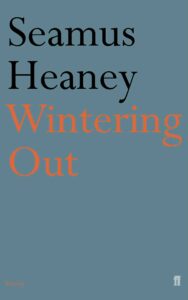Wintering Out struck me as even more oblique than Door into the Dark, and I often struggled to see and hear what Heaney was connecting with. Not that they have to be something that I can find on first reading, or even second or third. Wintering Out has the first appearance of Tollund Man, a figure that Heaney says in Stepping Stones appears in or influences numerous later poems in his career. The book was published in 1972, three years after his previous collection, and shortly before its publication he taught for a year at the University of California, Berkeley, a time most clearly reflected in the book’s final poem, “Westering.” It was a time that changed Heaney, too.
He tells Dennis O’Driscoll, “Something changed, all right. It was the first time we’d lived for any length of time outside Northern Ireland. The first time we lived in the sun. The first time when the pay was enough for us not to be always thinking about money. I was taller and freer in myself at the end of the year than at the beginning. And it wasn’t just the waft of the climate or the waiving of economic anxieties. It had to do with the intellectual distinction of the people around us, the nurture that came from new friendships and a vivid environment.” (Stepping Stones, pp. 136–37)
Later, O’Driscoll asks him, “The general assumption, then that the short line of Wintering Out is in the American, W[illiam] C[arlos] Williams grain is correct?” Heaney answers, “I believe it to be so, although there was already a drift in that direction in the landscape poems at the end of Door into the Dark. If I couldn’t altogether escape an Irishy/Britishy formality, I had an inclination from the start to dishevel it. I’ve always been subject to a perverse urge to galumph rather than glide.” (Stepping Stones, p. 146)
Wintering Out opens with the very short lines of “Fodder”:
Or, as we said,
fother, I open
my arms for it
again. But first
to draw from the tight
view of a stack
the weathered eaves
of the stack itself
falling at your feet,
last summer’s tumbled
swathes of grass
and meadowsweet
multiple as loaves
and fishes, a bundle
tossed over half-doors
or into mucky gaps.
These long nights
I would pull hay
for comfort, anything
to bed the stall.
At whose feet? I don’t know. Another person from the farm, one of the farm animals, I can’t really tell. The speaker of this poem, perhaps, turns up three poems later in “Servant Boy” whose opening stanza gives the book its title.
He is wintering out
the back-end of a bad year,
swinging a hurricane-lamp
through some outhouse;
a jobber among shadows. …
This is the rural or semi-rural life that has shown up in Heaney’s other two collections, this time with a bit more of the discontent of the have-nots, and distantly (to ears less tuned to local nuance) the class and sectarian conflicts, the latter of which had become the Troubles between Door into the Dark and Wintering Out. They are present in the collection, but it is, as I said, oblique.
“The Other Side” is the poem that addresses the divides most directly. It concerns a neighbor who seems to both look down on and envy the speaker’s family and farm, though it is not obvious at the poem’s opening that the neighbor is Protestant and the speaker Catholic.
The heart-stopping “Limbo” is one of the strongest in the collection. Others, like “Bye-Child” or “Shore Woman” inhabit a space between ballads handed down through generations and yesterday’s gossip. The volume that began with winter ends with spring; poems such as “May” or “First Calf” mark the turning of the year, “Dawn” the turning of the day. By the time Heaney ends with “Westering,” he’s headed somewhere else entirely. But California does not keep him; the next volume is titled North.


2 pings
[…] of it as “a very oblique and intense book” because I found it not nearly as oblique as Wintering Out or Door Into the Dark. Heaney divided North into two parts, “a first section that has poems […]
[…] of a Naturalist (1966) Door into the Dark (1969) Wintering Out (1972) North (1975) Field Work (1979) Station Island (1984) The Haw Lantern (1987) Seeing Things […]